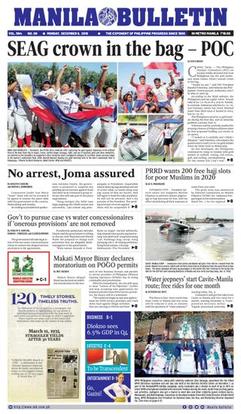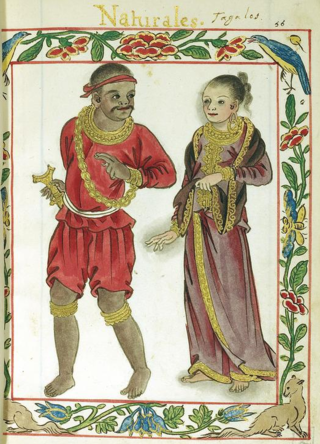Related Research Articles

The Visayas, or the Visayan Islands, are one of the three principal geographical divisions of the Philippines, along with Luzon and Mindanao. Located in the central part of the archipelago, it consists of several islands, primarily surrounding the Visayan Sea, although the Visayas are also considered the northeast extremity of the entire Sulu Sea. Its inhabitants are predominantly the Visayan peoples.

Panay is the sixth-largest and fourth-most populous island in the Philippines, with a total land area of 12,011 km2 (4,637 sq mi) and has a total population of 4,542,926 as of 2020 census. Panay comprises 4.4 percent of the entire population of the country. The City of Iloilo is its largest settlement with a total population of 457,626 inhabitants as of 2020 census.

Iloilo, officially the Province of Iloilo, is a province in the Philippines located in the Western Visayas region. Its capital is the City of Iloilo, the regional center of Western Visayas. Iloilo occupies a major southeast portion of the Visayan island of Panay and is bordered by the province of Antique to the west, Capiz to the north, the Jintotolo Channel to the northeast, the Guimaras Strait to the east, and the Iloilo Strait and Panay Gulf to the southwest.

Capiz, officially the Province of Capiz, is a province in the Philippines located in the central section of Western Visayas region. Its capital is the city of Roxas. It is located at the northeastern portion of Panay Island, bordering Aklan to the north, Antique to the west, and Iloilo to the south. Capiz faces the Sibuyan Sea to the north.

Visayans or Visayan people are a Philippine ethnolinguistic group or metaethnicity native to the Visayas, the southernmost islands of Luzon and a significant portion of Mindanao. When taken as a single ethnic group, they are both the most numerous in the entire country at around 33.5 million, as well as the most geographically widespread. The Visayans broadly share a maritime culture with strong Roman Catholic traditions integrated into a precolonial indigenous core through centuries of interaction and migration mainly across the Visayan, Sibuyan, Camotes, Bohol and Sulu seas. In more inland or otherwise secluded areas, ancient animistic-polytheistic beliefs and traditions either were reinterpreted within a Roman Catholic framework or syncretized with the new religion. Visayans are generally speakers of one or more of the Bisayan languages, the most widely spoken being Cebuano, followed by Hiligaynon (Ilonggo) and Waray-Waray.

Iloilo City, officially the City of Iloilo, is a 1st class highly urbanized city in the Western Visayas region of the Philippines, located on the southeastern coast of the island of Panay. It is the capital city of the province of Iloilo, where it is geographically situated and grouped under the Philippine Statistics Authority, but remains politically independent in terms of government and administration. In addition, it is the center of the Iloilo–Guimaras Metropolitan Area, as well as the regional center and primate city of the Western Visayas region. According to the 2020 census, Iloilo City has a population of 457,626 people. For the metropolitan area, the total population is 1,007,945 people.
Liwayway is a leading Tagalog weekly magazine published in the Philippines since 1922. It contains Tagalog serialized novels, short stories, poetry, serialized comics, essays, news features, entertainment news and articles, and many others. In fact, it is the oldest Tagalog magazine in the Philippines. Its sister publications are Bannawag, Bisaya Magasin, and Hiligaynon.
Bannawag is a Philippine weekly magazine published in the Philippines by Liwayway Publications Inc. It contains serialized novels/comics, short stories, poetry, essays, news features, entertainment news and articles, among others, that are written in Ilokano, a language common in the northern regions of the Philippines.
The Hiligaynon people, often referred to as Ilonggo people or Panayan people, are the second largest subgroup of the larger Visayan ethnic group, whose primary language is Hiligaynon, an Austronesian language of the Visayan branch native to Panay, Guimaras, and Negros. They originated in the province of Iloilo, on the island of Panay, in the region of Western Visayas. Over the years, inter-migrations and intra-migrations have contributed to the diaspora of the Hiligaynon to different parts of the Philippines. Today, the Hiligaynon, apart from the province of Iloilo, also form the majority in the provinces of Guimaras, Negros Occidental, Capiz, South Cotabato, Sultan Kudarat, and North Cotabato.

The Manila Bulletin is the Philippines' largest English language broadsheet newspaper by circulation. Founded in 1900, it is the second oldest extant newspaper published in the Philippines and the second oldest extant English newspaper in the Far East. It bills itself as "The Nation's Leading Newspaper", which is its official slogan.
Bisaya Magasin is a weekly Cebuano magazine now published by the Manila Bulletin Publishing Corporation, Philippines. It has the record of being the oldest magazine in Cebuano which is still published, and "the most successful periodical in Cebuano".

The Maragtas is a work by Pedro Alcantara Monteclaro titled History of Panay from the first inhabitants and the Bornean immigrants, from which they descended, to the arrival of the Spaniards. The work is in mixed Hiligaynon and Kinaray-a languages in Iloilo in 1907. It is an original work based on written and oral sources available to the author.

Hiligaynon, also often referred to as Ilonggo or Binisaya/Bisaya nga Hiniligaynon/Inilonggo, is an Austronesian regional language spoken in the Philippines by about 9.1 million people, predominantly in Western Visayas and Soccsksargen, most of whom belong to the Hiligaynon people. It is the second-most widely spoken language in the Visayas and belongs to the Bisayan languages, and it is more distantly related to other Philippine languages.

The Isyu Ngayon series was a brand of regional news magazine shows of different GMA Regional TV stations in the Philippines. They were aired weekly in Dagupan, Cebu, Iloilo and Davao on Saturday mornings; and aired daily in Naga, Bacolod, Cagayan de Oro and General Santos. The Isyu Ngayon family of programs was not available in the Metro Manila market. Its editions in Naga, Iloilo, Bacolod and Davao were aired internationally via GMA News TV International.

The Federal State of the Visayas was a revolutionary state in the Philippine archipelago during the revolutionary period. It was a proposed administrative unit of a Philippines under a federal form of government.

The Governor of Iloilo is the local chief executive of the Philippine province of Iloilo. The governor holds office at the Iloilo Provincial Capitol located at Bonifacio Drive, Iloilo City. Like all local government heads in the Philippines, the governor is elected via popular vote, and may not be elected for a fourth consecutive term. In case of death, resignation or incapacity, the vice governor becomes the governor. Along with the governors of Aklan, Antique, Capiz, Guimaras and Negros Occidental, he sits in the Regional Development Council of the Western Visayas Region.
Hiligaynon literature consists of both the oral and written works in Hiligaynon, the language of the Hiligaynon people in the Philippine regions of Western Visayas and Soccsksargen.

The Iloilo Museum of Contemporary Art (ILOMOCA) is an art museum in Iloilo City, Philippines. It is the first museum in the Visayas and Mindanao dedicated to modern art.
References
- ↑ Leoncio P. Deriada, Hiligaynon Literature, The National Commission for Culture and the Arts Archived July 28, 2011, at the Wayback Machine Retrieved August 26, 2013
- ↑ Hiligaynon Archived December 20, 2013, at the Wayback Machine Retrieved August 26, 2013